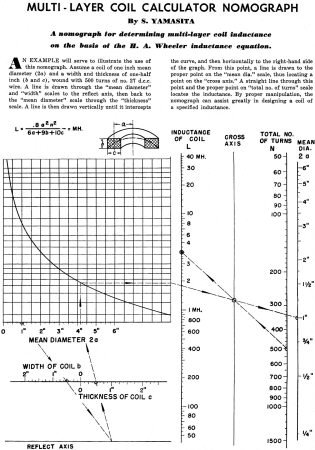Multi-Layer Coil Calculator Nomograph |
||
Plenty of single-layer coil (inductor) winding calculators, charts, and nomographs can be found on the World Wide Web, but finding one for multi-layer coils is a bit harder - until now. Actually, this Multi-Layer Coil Calculator Nomograph appeared in a 1955 issue of Radio & Television News magazine. It was an era long before personal calculators, computers, and smartphones, when long-hand written-out problem solving was the norm, and slide rules made such tasks easier for those fortunate enough to know how to work one. I did a little head scratching upon encountering the term "no. 27 d.c.c. wire," not being familiar with the "d.c.c." part. A little research turned up that it means "double cotton covered" for insulation, and there was also "s.c.c." for single cotton covered. Belden and Alpha used to make it. Enamel-covered wire is now used for winding coils and transformers. As you might expect, some companies who specialize in replicating vintage components still make the cotton-covered wire (here's another), or at least something that looks like it but is better quality. Multi-Layer Coil Calculator Nomograph A nomograph for determining multi-layer coil inductance on the basis of the H. A. Wheeler inductance equation. An example will serve to illustrate the use of this nomograph. Assume a coil of one inch mean diameter (2a) and a width and thickness of one-half inch (b and c), wound with 500 turns of no. 27 d.c.c. wire. A line is drawn through the "mean diameter" and "width" scales to the reflect axis, then back to the "mean diameter" scale through the "thickness" scale. A line is then drawn vertically until it intercepts the curve, and then horizontally to the right-hand side of the graph. From this point, a line is drawn to the proper point on the "mean dia." scale, thus locating a point on the "cross axis." A straight line through this point and the proper point on "total no. of turns" scale locates the inductance. By proper manipulation, the nomograph can assist greatly in designing a coil of a specified inductance.
Posted September 30, 2021 Nomographs / Nomograms Available on RF Cafe: - Parallel Series Resistance Calculator - Transformer Turns Ratio Nomogram - Symmetrical T and H Attenuator Nomograph - Voltage and Power Level Nomograph - Nomogram Construction for Charts with Complicating Factors or Constants - Voltage, Current, Resistance, and Power Nomograph - Resistance and Capacitance Nomograph - Voltage, Power, and Decibel Nomograph |
||

